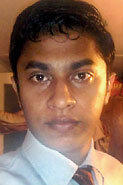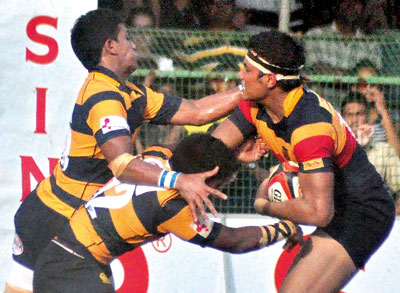Music and visuals, a perfect plus
By Dr. Asoka de ZoysaIs it bad taste to sway on the piano stool when playing and slowing down the tempo ad libitum, especially if one is playing to an audience? It seemed that Malinee Jayasinghe-Peris, that icon of Sri Lankan music did not care to follow that rule, when she played Robert Schuman’s “Tr�merei” as the curtain call at the Hauskonzert on May 26, 12.
The Hauskonzert, was the second of its kind organized by the Chamber Music Society (CMS) of Colombo and the Goethe Institute. It was an invitation to interact with chamber music in a more intimate surrounding. The title of the evening “Chamber Music Plus” meant that there was to be a contribution by the artist Muhanned Cader. This left many questions open, how two artists from two generations were going to react to a common topic “water”.
I always envied the audience that heard Malinee play Beethoven’s fourth piano concerto at the first concert of the Colombo Symphony Orchestra in 1953. Professor Peris who has given concerts in most of the capital cities in Europe, Israel, Australia and the United States, where she currently lives, is a rare but much loved pianist in Sri Lanka.
The principals of the CMS opened the evening with the Symphonia “Arrival of the Queen of Sheba” by H�ndel, justly announcing the arrival of Professor Peris on stage. The concert master of the CMS Lakshman Joseph de Saram, who is known to throw lesser known pearls of music to his audiences in Colombo had chosen the single movement of Gustav Mahler’s unfinished piano quartet.
“Water” was the theme of the main programme featuring the pianist and visual artist. As Muhanned was not present in the room, the audience was left to relate the music to the photographed images from his series of paintings from 2011 entitled “Drawing Ocean”.
A long odyssey of music from Chopin to Liszt followed.
Malinee spoke of her childhood memories of reading Longfellow’s “Song of Hiawatha”, gold fish in a restaurant in Shanghai, the moon reflected on the Kandy lake, the legends of the water sprite “Ondine” hinting at times of what the audience was to discover in the layers of music that were to flood the room. She related anecdotes, narrated legends and read poems, playing Chopin’s Barcarolle in F sharp major, Debussy’s “Goldfish” and “Reflections on the water” Ravel’s Ondine (“The Water Sprite”) and Liszt’s “St. Francis of Paola walking on the waves”. Water that made the boat sway, that creates ripples and waves when goldfish swim, water under which the mermaid like creature allures and arouses desire, and water that can be used to walk on, if one had the spiritual power.
The audience was informed that impressions of the devastations created by the tsunami experienced on the southern coast were the starting point for Muhanned’s series of paintings. They kept appearing on the screen behind, while the piano played. One could see that the images were not just beautiful “Nightscapes” by the water. This series was more daring: The artist who had left the standard rectangular shape for his canvas, in this series had cut his canvas into bizarre and spooky shapes. It was obvious that the CMS had not intended to make Malinee “illustrate” Muhanned’s visual impressions. Nor had Muhanned tried to provide images like Wassily Kandinsky to Modest Mussorgsky music “Pictures from an Exhibition”.
It was up to the audience to make or not make the connection between image and music. If one felt disturbed by the images, one could concentrate on the music that flowed out of the piano changing tone and colour. What was remarkable was that at times moods created image and music did reflect each other. Sometimes colourful reflections on water from Debussy were juxtaposed against a monster like-figure or a dishevelled head on the screen. As much as Muhanned’s images were multilayered, melodic phrases emerged out of the multitude of notes that cascaded from the piano.
Even if a melodic line was broken, Malinee was able to recapture it with the same intensity and develop it further in the next sequence. What most fascinated me was Malinee’s analytical playing, which made me at times almost see the notes she was playing.
At the back of the Goethe Hall one was not able to hear every word Malinee spoke, but the ideas were conveyed. Through the words and snatches of phrases one was able to “hear out” what she meant, just as one could pick out the melodic lines by Ravel and Liszt, when she played. The silence between the notes at times, waiting for the next note or chord was the greatest joy of listening to Malinee that evening.
I remember Carmel Raffel saying at a rehearsal that only some music we have learnt to play, however simple, will take us through life. We would find that in different situations we would interpret the same piece in an entirely different style. Listening to the curtain call “Tr�umerei”, I felt that Malinee did not play for the audience, but for herself. I would even go further: I am sure that Malinee would have played this excerpt very differently if she would play it in the context of the entire set of pieces “Scenes from Childhood” . Similarly, most of the works interpreted that evening were very personal interpretations, maybe connected to memories and feelings of the past. Only a few pianists would be capable of conveying them to an audience.
Malinee opened the evening with a homage to Sita Joseph de Saram, the well known artist and much loved music teacher. What could be a better way of paying tribute than combining visual art and music to that great teacher? Her pupils will remember how she inspired many of us to play beyond just passing exams, but experiment with instruments, trying out unusual ensemble playing ending in real Hauskonzerts at her home in Lauries’ Road. The experiment of combining Malinee’s very personal playing and Muhanned’s very personal style in expressing emotions was a challenge. To me the “plus” at the concert was a success. Lakshman chose the difficult path, rather than just projecting some images of Claude Monet or the Pre-Raphaelites downloaded from the internet on the screen.
comments powered by Disqus

















